Not too long ago, I received the new FiiO M11 Portable Music Player along with the new FiiO FH7 IEMs and the new FiiO LC-4.4D 4.4mm to MMCX high-purity Monocrystalline Silver Litz IEM cable. At the time I reviewed the FiiO M11, and now it is time to cover the other two products. One aspect of FiiO as a company is that they are constantly pumping out new products, so it is often difficult to keep up. Another aspect is those new products are always an improvement over the past. FiiO is well known for producing high-performance budget products, but now they are stepping up their game to remove that budget moniker. FiiO’s previous Flagship IEM the F9PRO was an amazing IEM for the money, but the FiiO FH7 launches them firmly into the middle of mainstream IEMs.

FiiO FH7 IEM:
So the basic features of the FiiO FH7 are as follows:
- Five Driver Hybrid Design
- Four Knowles Balanced Armature Drivers
- One 13.6mm Beryllium-plated Diaphragm Dynamic Driver
- Patented S.TURBO V2.0 Acoustic Design
- Independent Sound Tubes as part of Complex Crossover Design
- Aerospace-grade Aluminum-magnesium Alloy Shell
- Optimized Internal Structure and Damping to Relieve Uneven Pressure to Eardrum
- Exceptionally Rigid Three-point Structure for Greatly Reduced Unwanted Resonance and Distortion
- Three Pairs Interchangeable Color-coded Sound Filters
- Eight Strand 152 Wire High-Purity Monocrystalline Silver-plated Copper Litz IEM cable
S.TURBO acoustic design entails the creation of a matrix of longer sound tubes in a turbine configuration optimized to create deeper more robust bass. This is achieved by using a five-axis CNC machine in a 21 step program with a total of 3873 cuts. The attention to detail includes a final stage of hand polishing. The driver complement employs the dynamic driver for bass, a pair of modified Knowles DFK-30017 drivers for the midrange, and a pair of Knowles SWFK-31736 drivers as tweeter and supertweeter to cover the high and ultra-high frequencies.
As to the filters; Red is Dynamic Bass Emphasis, Black is Balanced (neutral) and Green is Detailed Treble Emphasis.

LC-4.4D 4.4mm to MMCX high-purity Monocrystalline Silver Litz IEM cable:
Take 8 strands of high-purity Monocrystalline Silver fiber, each wrapped in a DuPont sheath, twisted around a core to create a wire, then braid together 7 of these wires into a single larger strand encased in a medical-grade transparent PVC sleeve with a special protective coating (to make the wire more flexible with less microphonics) and weave 4 of these larger strands together and add a 4.4mm balanced TRRRS connector at one end and MMCX connectors with ear-hook outer sleeves on the IEM side and you have the FiiO LC-4.4D 4.4mm to MMCX high-purity Monocrystalline Silver Litz IEM cable.
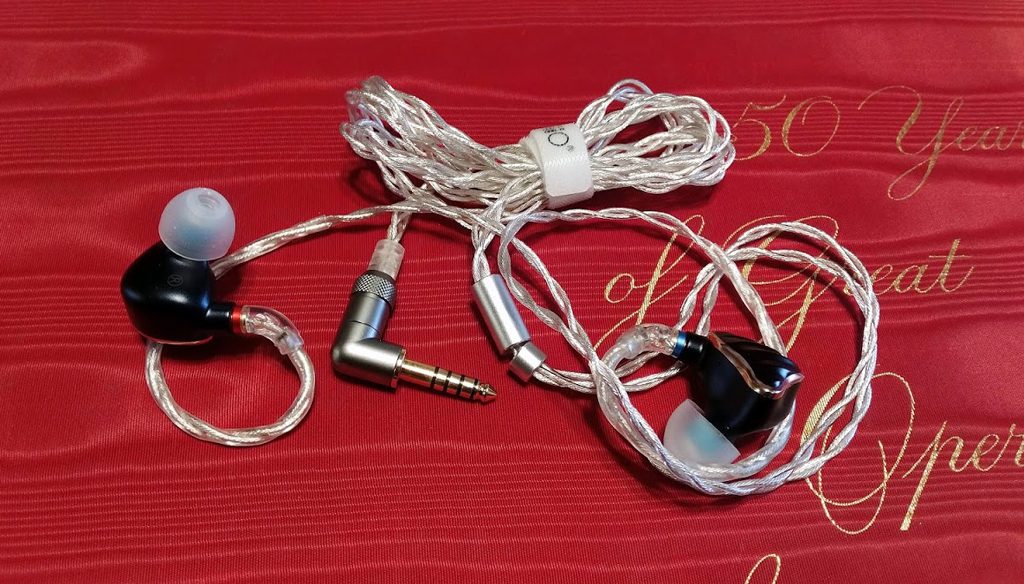
Living With the FiiO FH7 IEM:
The first thing that impressed me was the box for the FiiO FH7 was, in fact, larger than the box for the FiiO M11, which I found interesting given the relative size of the products. After removing the outer picture sleeve and opening the magnetic clasp box (which had a pleasant textured silicone-like finish) I found a one-inch block of hard foam containing the FH7s, the stock cable and a small black capsule (with a screw-on cover) containing the alternate filters. Under the foam block was a one half inch hard foam block containing an array of 14 sets of tips in addition to the ones already fitted on the FH7, and a padded leatherette hard-shell case. Under the foam block with the tips was a small black box with the paperwork, and inside the hard-shell case was another padded denim soft shell case, and inside that was a magnetic cable clasp and an IEM cleaning brush. Talk about Russian Doll!
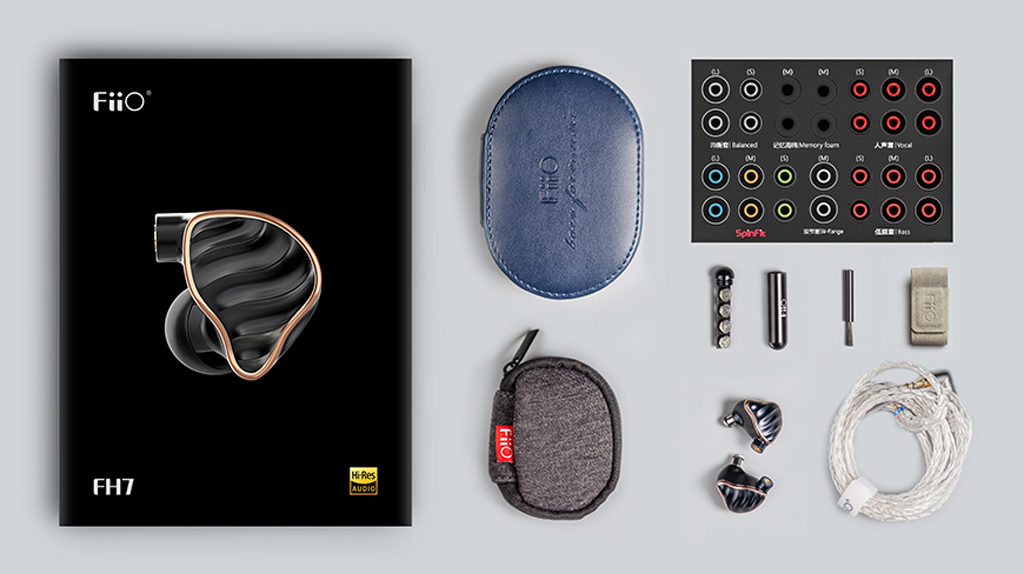
The tip selection was epic, there were 3 sets (Large, Medium, Small) of silicone tips labeled “Balanced”, 3 sets of silicone tips labeled “Vocal”, 3 sets of silicone tips labeled “Bass”, 3 sets of SpinFit tips, 2 sets of medium memory foam tips and one set of medium Bi-flange silicone tips.
I began my listening tests with the Balanced filters, the Medium Balanced tips, and the stock single-ended cable with the FiiO M11. Pulling up “Can-Utility and the Coastliners” (Genesis – 16/44.1kHz) on Qobuz it became instantly obvious that tip selection would have to come first. For the Balanced tips, I found the large to be the most comfortable and provide the best seal, but the sound was not what I was looking for in my neutral setting. The midrange was a bit pronounced and the bass was more in the background than I expected.

I then moved to the SpinFit, opting for the large tips out of the gate. These provided a more even tonal balance, more in line with what I was initially expecting. I next tried the Bi-flange but these simply did not seal without constant pressure on the IEM, so I moved on to the Memory Foam tips. These offered a bit more meat in the mid-bass as well as a bit more oomph and extension on the bottom end.
As expected, the Vocal tips offered a much brighter interpretation. I anticipated that the Bass tips would sound similar to the Memory Foam tips as they were similar in the shape of the opening, but in fact, they were much heavier on the bass side of things. Not unpleasantly so, pretty much in keeping with the more popular over-ear headphones, but definitely skewed towards the bass enthusiast.
Since I found the SpinFit to be the most comfortable, I tried them with the Bass filter to see if I could get something closer to the Memory Foam sound. This combination in my experience produced the most neutral tonal balance and allowed for the greatest comfort, permitting me to move on to other aspects of the sound. Peter’s voice was both intimate and expansive as if recorded in a large hall or studio, and the other instruments, guitars, keyboards and flute were positively ethereal, enveloping you in three dimensions of sound. The percussion was sharp and defined and the bass had excellent extension into the subsonic range. (A note on the comfort, this is individual, and not likely something you’ll encounter, I have always had issues with universal IEMs, especially ones with large nozzles like the FH7s. This is purely a physical thing, and in no way was associated with the sound.)

Moving to the Questyle Audio CMA400i Current Mode DAC/Amplifier, I cued up Ole Satchmo’s “What a Wonderful World” (Single Version – 24/192kHz). The soundstage was large theater presentation with a richness to the strings, woodwinds, and guitar. The upright bass had a very natural sound and the vibes were exceptionally musical. Louis Armstrong’s vocal was clear and powerful, with a sense of distance and air.

It was necessary to perform my smartphone tests before switching cables so that came up next, and I powered up my antique Samsung Galaxy J3 as it has a headphone output. Choosing Liz Story’s “Wedding Rain” (16/44.1kHz) I was treated to delicate Steinwayesk piano in a large recital hall, musical and not the least bit fatiguing.
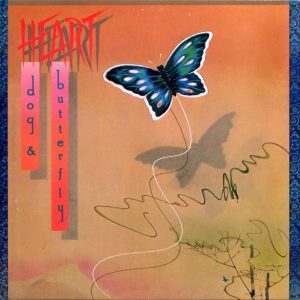
It was time to up the game and change to the LC-4.4D 4.4mm to MMCX high-purity Monocrystalline Silver Litz IEM cable. Firing up the ifi Pro iDSD in tube mode and putting on “Dog & Butterfly” by Heart (Dog & Butterfly – 24/192kHz), the FiiO FH7s were transformed into a true high-end IEM, with air and texture, and just more. Greater depth to the soundstage, more precision to the image, greater dynamics, and more copious resolution.

Returning to the FiiO M11 which also has a 4.4mm connection I selected “Time of the Season” by The Zombies (Greatest Hits – DSD) and the haunting rendition, spoke to this being the perfect combination of source and playback for this song.

Though most of the music I had selected so far had orchestral elements, I had a real feeling that the FiiO FH7 was a classical lover’s IEM, so I finished off with Beethoven’s 9th on Qobuz (Leonard Bernstein – Wiener Philharmoniker – 24/192kHz) and was not disappointed. The choral was huge, and the dynamics amazing. I could easily delineate separate flutes, violins, and voices as they performed in harmony.
Conclusions on the FiiO FH7 IEM with the FiiO LC-4.4D 4.4mm to MMCX high-purity Monocrystalline Silver Litz IEM cable:
The sizable selection of ear-tips and filters makes the FiiO FH7 a one size fits all IEM. It produces detail to compete with the big boys and yet can cater to the Hip Hop and bass-head crowd at the same time. While not exactly what you would call forgiving, they don’t punish you for low-resolution sources, while still being able to scale up to match your gear.
Though they would easily compete with others in their price range, stepping up to the Silver cable will more than satisfy the resolution hungry.
A definite bargain.
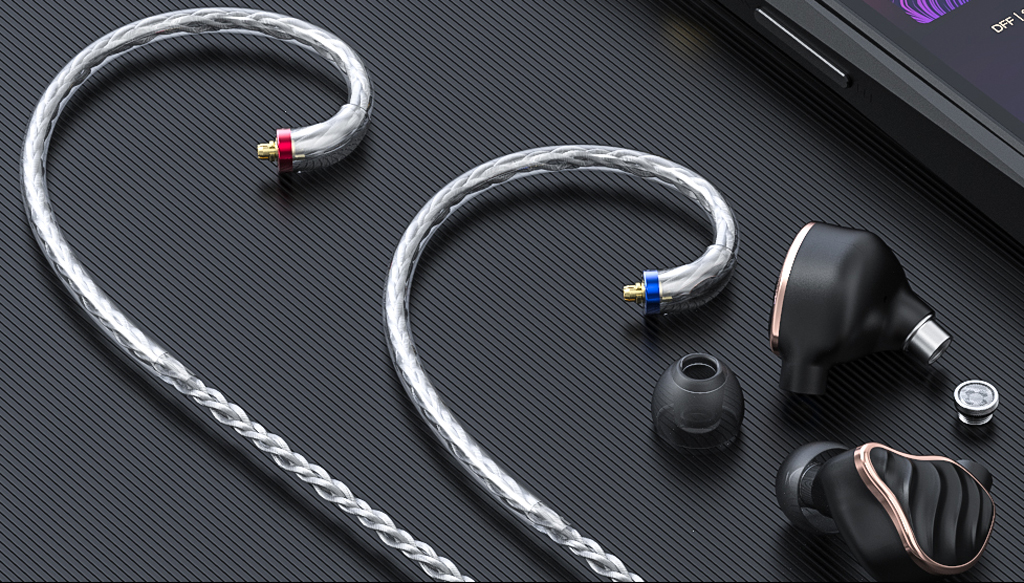
FiiO FH7 https://www.fiio.com/fh7
Price:
FH7 $449.99 USD
LC-4.4D $99.99 USD
Specifications:
| Headphone Type | Over-the-ear |
| Impedance | 16Ω(@1kHz) |
| Frequency Response | 5Hz – 40kHz |
| Cord Length | 120cm |
| Sensitivity | 111dB/mW |
| Plug Type | 3.5mm |
| Driver Type | 1 Dynamic + 4BAs(knowles) |
| Maximum Input Power | 100mW |
| Single Earbud Weight | About 8.15g |














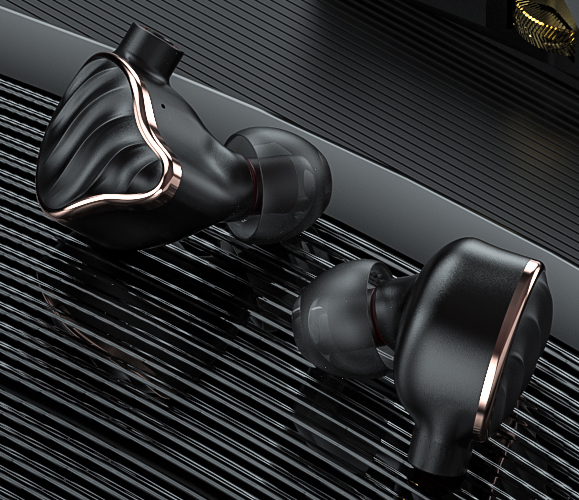
Want to join discussion?
Feel free to contribute!